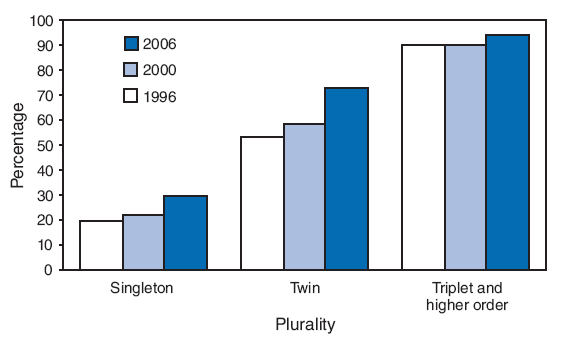Persons using assistive technology might not be able to fully access information in this file. For assistance, please send e-mail to: mmwrq@cdc.gov. Type 508 Accommodation and the title of the report in the subject line of e-mail.
QuickStats: Percentage of Live Births by Cesarean Delivery, by Plurality --- United States, 1996, 2000, and 2006

The percentage of live births by cesarean delivery varies substantially by plurality. In 2006, the percentage was 72.9% for births in twin deliveries and 93.9% for births in triplet and higher order deliveries, compared with 29.6% for singleton births. From 1996 to 2006, the percentage of cesarean deliveries increased 50% for singletons and 37% for twins. The percentage of cesarean deliveries for triplet and higher order deliveries remained high throughout 1996--2006, increasing slightly from 2000 to 2006.
SOURCE: National Vital Statistics System, 1996, 2000, and 2006. Available at http://www.cdc.gov/nchs/births.htm.
Alternative Text: The figure above shows the percentage of live births by cesarean delivery, by plurality, in the United States in 1996, 2000, and 2006. In 2006, the percentage was 72.9% for births in twin deliveries and 93.9% for births in triplet and higher order deliveries, compared with 29.6% for singleton births. From 1996 to 2006, the percentage of cesarean deliveries increased 50% for singletons and 37% for twins. The percentage of cesarean deliveries for triplet and higher-order deliveries remained high throughout 1996-2006, increasing slightly from 2000 to 2006.
Use of trade names and commercial sources is for identification only and does not imply endorsement by the U.S. Department of
Health and Human Services. |
All MMWR HTML versions of articles are electronic conversions from typeset documents. This conversion might result in character translation or format errors in the HTML version. Users are referred to the electronic PDF version (http://www.cdc.gov/mmwr) and/or the original MMWR paper copy for printable versions of official text, figures, and tables. An original paper copy of this issue can be obtained from the Superintendent of Documents, U.S. Government Printing Office (GPO), Washington, DC 20402-9371; telephone: (202) 512-1800. Contact GPO for current prices.
**Questions or messages regarding errors in formatting should be addressed to mmwrq@cdc.gov.Date last reviewed: 5/21/2009


